Boutique dog food gets new digs
A new line of boutique cann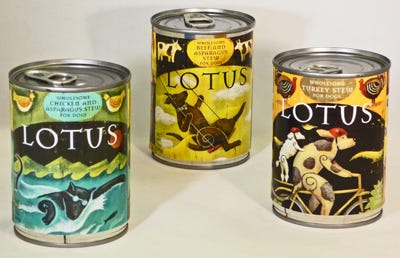
L-beauty-1.jpg
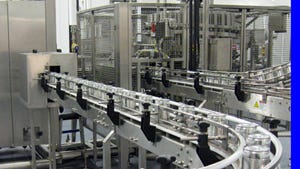
L-Elmar.jpg
ed dog food is opening new markets for Lotus Natural Pet Foods, Torrance, CA. Everything about the enterprise is new-new products, a new packaging line and a new facility. The new operation builds on the company's history of making unique superior pet foods. It started with a line of dried foods that were baked instead of extruded like most dried pet foods, and that were made from the highest quality ingredients in their most whole, natural form.
With this success, the company decided to expand into a line of boutique canned dog food, and winter 2010 it built the new plant and installed the new line. Lotus president Darom Matsuura had been affiliated with Centinela Feed and Pet Supplies, which owns a line of retail pet stores in Los Angeles, so he arranged to acquire 120,000 sq ft in the Centinela distribution center and built a 40,000-sq-ft canning facility inside the DC. The architect for the project was Vertrees A&E. Accurate Industrial Construction Inc. installed all of the equipment and built the overhead catwalks.
Sterling Consulting Inc. was the systems integrator for the project. "Lotus wanted a high-quality, relatively low-speed canning line that could grow as the business grew," says Sterling president Steve Day. "Primary equipment purchases were a combination of new and refurbished to optimize capital spending."
Line runs three can sizes
The line, which is designed to run three can sizes at 300 cans/min, was running 13.2-oz cans of beef and sparagus stew during PD's visit. It can also run 3- and 6-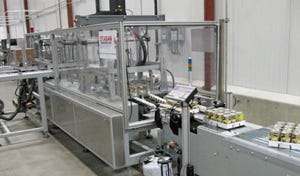
L_Staban-machine.jpg
oz sizes. The cans, which are supplied by Silgan Containers, are received stacked in layers on pallets. The cans are depalletized on a machine from Can Lines Engineering that was rebuilt by Can Lines to meet Lotus' requirements.
The depalletizer raises the pallet one layer at a time, and an arm sweeps the cans onto a bulk takeaway conveyor. The cans are single filed and the conveyor, which travels just beneath the ceiling, passes through a wall into the filling room. For sanitation reason, process, filling and seaming are done in this separate room.
As the cans descend to the filler, they travel through a washer supplied by Sim-Co Fabricators Inc. that sprays water into them as they are twisted through 360 deg. The washer is equipped with three lanes and gates at the entrance and exit to direct the cans into the correct lane for the size that is being run.
Piston filler/seamer monobloc
The cans then enter an Elmar Industries Inc. Model 528 piston filler that Elmar rebuilt for 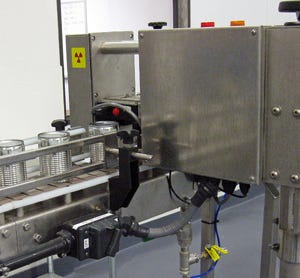
L-Peco.jpg
this application. "Our rebuilt machines are upgraded to the same quality level as our new machines," says Elmar president Mark Dahlquist, "and they cost considerably less." The 28-head filler is equipped with a temperature and filler bowl level control system and is capable of speeds to 500 cans/min.
Elmar assembled the filler as a monoblock on a stainless steel tubular common frame with a new model 406 six-spindle can seamer from Ferrum Canning Machinery. ShoreLine PPM LLC is a North American agent for Ferrum.
The system incorporates a Movitrac electronic synchronization system from SEW-Eurodrive USA that eliminates mechanical gearboxes and power transmission-related items between the filler and seamer. The monobloc also includes a new electronic control system featuring an Allen-Bradley PLC and HMI from Rockwell Automation.
The controls include a menu that enables an operator to select the can size and product that is running with the push of a button and the controls will set both the filler and seamer accordingly.
It includes a no-container/no-fill system that stops the piston movement in a fill head if a can is not present and a container gate stop that enables the operator to interrupt bottle infeed to the filler at a touch of a button on the HMI in case of a down-stream stoppage. The cans travel through a Peco Controls Corp. Ga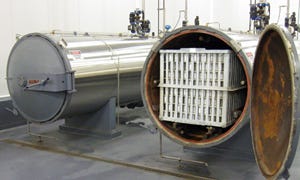
L-Allpax.jpg
mma 101P fill-level monitor that checks for under-filled cans. The unit maintains a count of all acceptable and under-filled cans.
This is followed by a Sonic Air Systems Inc. air knife that blows off any water that is remaining on the outside of the cans.
The can conveyor passes through a wall into the retorting room and the cans travel through a Markem-Imaje Model 9020 small-character inkjet printer. The unit provides easy access to key commands via icons and features an advanced printhead that incorporates a patented automatic nozzle rinsing system that ensures hassle-free start-ups.
The cans are conveyed to a semi-automatic basket loader from A&B Engineering Service. The cans enter a table that indexes upward after it is filled and forms a complete layer. An arm pushes the layer onto a plate in the retort basket.
The plate is then lowered into the basket until there is room for the next layer, and the loader repeats the process. When the basket is full, a forktruck equipped with a scissors style clamping unit lifts it up and places it on the rails of a retort.
Lotus has four retorts from Allpax Products LLC that hold six baskets of cans each. The retorts, which feature steam heating and flooded-water cooling are 52-in. in diameter and 24.75 feet long. Operating conditions depend on the can size being run, but a typical batch would be cooked at about 250 deg F for 80 min with 15 min each for heating and cooling.
Allpax completely rebuilt the retorts with new piping and valves and new controls that incorporate the latest control package. At the end of a cooking cycle, the baskets are removed from the retort and taken to another A&B Engineering unit that reverses the loading procedure and places the cans onto a conveyor. As with most of the equipment on the line, the basket loader and unloader were rebuilt by the manufacturer.
Tray loader and wrapper
The cans pass through another wall into the distribution area where the downstream equipment is located. The cans travel through another Sonic air knife and then enter a Burt model 408 horizontal roll-through labeler from Pneumatic Scale Angelus.
Infeed twisters turn the cans on their sides as they enter the unit and discharge twisters return the cans to their upright positions as they leave.
Cut-and-stack labels are fed from the label magazine by a hydraulic system and a contact wheel applies hot-melt adhesive to the labels, which wrap around the cans as they roll through the unit.
From the labeler, the cans are conveyed to a tray packer, stacker and shrink wrapper built by Staban Engineering Corp. Cans travel to the Model W01 wraparound tray packer in bulk and enter lanes that determine the packing pattern.The 13.2-oz cans are arranged in a 3 lane x 4 deep pattern and 3.0-oz cans are in a 4 lane x 6 deep pattern. The rows of cans are then conveyed onto plates above a tray blank.
Tray blanks are fed into the packer at the appropriate time from a magazine on the side of the machine. When the tray blank is in the correct location, plates open and deposit the cans directly onto the blank. A descent table lowers the blank and cans, and stationary tooling folds the tray's blank sides around the cans.
Indexing pockets transfer the formed, unglued tray of cans downstre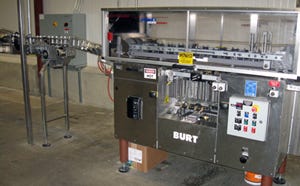
L-burt.jpg
am past glue guns where hot-melt adhesive is applied onto the tray side flaps. The product and tray enter the last station, where the tray is compressed by two cylinders prior to being discharged from the machine.
All the machine functions are controlled by a PLC. In addition the machine is equipped with an ITW Dynatec Quattro-Challenger computerized hot-melt glue system. The Dynatec unit uses a constant-pressure piston pump and a micro processor to closely control the temperature and dispensing of the hot melt adhesive.
Next, trays are turned 90 degrees through a Staban Model U01 tray turner. A Markem-Imaje model 4020 Series large-character inkjet printer applies a lot code and date to the side of the tray.
The printed tray enters a Staban Model C02 tray stacker that stacks the trays two-high. The trays of cans are held back in groups, and are then lifted on each side by a set of forks. The next group is conveyed beneath the forks and the flow of trays at the infeed is stopped.
Next, the forks pull out from under the top layer of trays and they descend a short distance onto the bottom layer of trays. At this point a discharge gate, which also serves to keep the stacked trays even, opens to allow the stack to exit. Lotus does not always stack trays, so w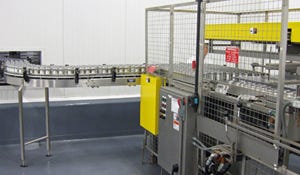
L-busse.jpg
hen it is not stacking trays, trays move through the machine untouched.Finally the trays are shrink wrapped using a Staban Model B01 shrink wrapper with a Model H01 heat tunnel. The wrapper is an intermittent-motion machine that can process up to 28 trays/min. The wrapper and tunnel can accommodate many different tray sizes, including the double tiered trays.
All of the equipment for the project was purchased used and was rebuilt by Staban Engineering. The equipment at Lotus went through the Gold rebuild program.
In this process, the machines are disassembled and repainted, and all components are inspected and replaced as needed. At completion, the machines are basically like new.
The trays are hand palletized and the pallets are stretched wrapped by a Cousins Packaging Inc. semi-automatic wrapper. The equipment all uses Allen-Bradley components and HMIs from Rockwell Automation.
"The line is running very well," says Day. "All-in-all, this has been a very successful project."
Accurate Industrial Construction Inc., 714-879-7017. www.aic580.com
A&B Engineering Service, 920-326-6348. www.arrowheadsystems.com
Allpax Products LLC, 888-893.9277. www.allpax.com
Can Lines Engineering., 562-861-2996. www.canlines.com
Cousins Packaging Inc. 888-209-4344. www.cousinspackaging.com
Elmar Industries, Inc., 716-681-5650. www.elmarworldwide.com
Ferrum Canning Machinery, 410-939-7734. www.ferrum-us.com
ITW Dynatec, 615-824.3634. www.itwdynatec.com
Markem-Imaje, 866-263-4644. www.markem-imaje.com
Peco Controls Corp., 800-732-6285. www.pecocontrols.com
Pneumatic Scale Angelus, 330-923-0491. www.pneumaticscale.com
Rockwell Automation, 414-382-2000. www.rockwellautomation.com
SEW-Eurodrive USA. 864-439-8792. www.seweurodrive.com
ShoreLine PPM LLC, 410-939-7734. www.ferrum-us.com
Silgan Containers, 203-975-7110. www.silgancontainers.com
Sim-Co Fabricators Inc. 909-597-7804. www.simcofab.com
Sonic Air Systems Inc., 714-255-0124. www.sonicairsystems.com
Staban Engineering Corp. 888-782-226. www.staban.com
Sterling Consulting Inc., 949-481-8705. www.sterlingconsultinc.com
Vertrees A&E, 714-255-9645. www.vertreesae.com
About the Author(s)
You May Also Like


